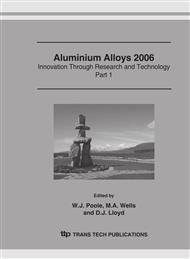p.841
p.847
p.853
p.859
p.865
p.871
p.877
p.883
p.889
Nonuniform Temperature Distribution in Adiabatic Shear Band Using Measured Shear Stress-Shear Strain Curve in Torsion of Thin-Walled Tube Aluminium Alloy Specimen and Gradient-Dependent Plasticity
Abstract:
Gradient-dependent plasticity where a characteristic length is involved to consider the microstructural effect (interactions and interplaying among microstructures due to the heterogeneous texture) and the measured nonlinear shear stress-shear strain curves for different loading strain rates are used to calculate the distribution of local temperature rise in adiabatic shear band (ASB) for aluminum-lithium alloy specimen of thin-walled tube in dynamic torsion test. ASB is assumed to initiate just at peak shear stress in the specimen. The temperature rise in ASB is decomposed into the uniform temperature rise in strain-hardening stage and the nonuniform temperature rise in strain-softening stage. The former depends on the measured nonlinear shear stress-shear strain curve prior to the peak, the density, the work to heat conversion factor and the heat capacity. The latter is related to the softening branch of the measured nonlinear shear stress-shear strain curve, the internal length parameter and the physical parameters. For binary Al-Li alloy, the predicted maximum temperatures in ASB are 413K at strain rate of 2000s-1 and 433K at strain rate of 2600s-1. These peak temperatures are lower than the recrystallization and phase transformation temperatures. Higher loading strain rate results in higher pre-peak and post-peak temperature rises, steeper profile of local temperature and higher peak local temperature in ASB. These predictions qualitatively agree with the previously analytical solution for ductile metal exhibiting linear strain-softening behavior beyond the peak shear stress based on gradient-dependent plasticity.
Info:
Periodical:
Pages:
865-870
Citation:
Online since:
July 2006
Authors:
Price:
Сopyright:
© 2006 Trans Tech Publications Ltd. All Rights Reserved
Share:
Citation:


